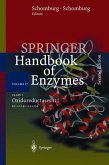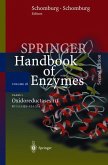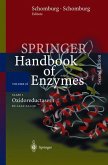The objective of the Springer Handbook of Enzymes is to provide in concise form data on enzymes sufficiently well characterized. Data sheets are arranged in their EC-Number sequence. Each volume comprises one enzyme class, sometimes the enzyme classes have to be divided into several volumes. Considerable progress has been made in enzymology since the publication of the first edition (published as "Enzyme Handbook"): many enzymes are newly classified or reclassified. In the 2nd edition each entry is correlated with references and one or more source organisms. New datafields are created: "application" and "engineering" (for the properties of enzymes where the sequence has been changed). Altogether the amount of data has doubled so that the 2nd edition will consist of approx. 25 volumes. This collection is an indispensable source of information for researchers in biochemistry, biotechnology, organic and analytical chemistry, and food sciences.
Springer Handbook of Enzymes provides data on enzymes sufficiently well characterized. It offers concise and complete descriptions of some 5,000 enzymes and their application areas. Data sheets are arranged in their EC-Number sequence and the volumes themselves are arranged according to enzyme classes.
This new, second edition reflects considerable progress in enzymology: many enzymes are newly classified or reclassified. Each entry is correlated with references and one or more source organisms. New datafields are created: application and engineering (for the properties of enzymes where the sequence has been changed). The total amount of material contained in the Handbook has more than doubled so that the complete second edition consists of 39 volumes as well as a Synonym Index. In addition, starting in 2009, all newly classified enzymes are treated in Supplement Volumes.
Springer Handbook of Enzymes is an ideal source of information for researchers in biochemistry, biotechnology, organic and analytical chemistry, and food sciences, as well as for medicinal applications.
Springer Handbook of Enzymes provides data on enzymes sufficiently well characterized. It offers concise and complete descriptions of some 5,000 enzymes and their application areas. Data sheets are arranged in their EC-Number sequence and the volumes themselves are arranged according to enzyme classes.
This new, second edition reflects considerable progress in enzymology: many enzymes are newly classified or reclassified. Each entry is correlated with references and one or more source organisms. New datafields are created: application and engineering (for the properties of enzymes where the sequence has been changed). The total amount of material contained in the Handbook has more than doubled so that the complete second edition consists of 39 volumes as well as a Synonym Index. In addition, starting in 2009, all newly classified enzymes are treated in Supplement Volumes.
Springer Handbook of Enzymes is an ideal source of information for researchers in biochemistry, biotechnology, organic and analytical chemistry, and food sciences, as well as for medicinal applications.
ChemBioChem 3/2002: Comparing Volume 2 of the first edition with Volume 1 of the second edition one rapidly notices that an incredible amount of work was spent on updating the different datafields.
The handbook is definitely worth buying, since it is probably the best reference manual available to date and is, therefore, an important acquisition for libraries. (W. Kroutil, University of Graz)
The handbook is definitely worth buying, since it is probably the best reference manual available to date and is, therefore, an important acquisition for libraries. (W. Kroutil, University of Graz)








